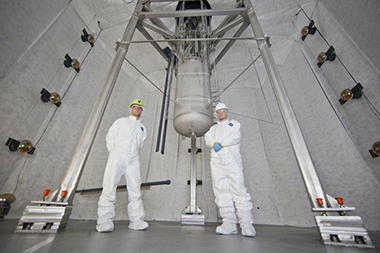Bringing Dark Matter to Light
Physicist Matthew Szydagis is part of a worldwide scientific collaboration to locate elusive particles and reveal fundamental truths about the universe.
 |
|
Matthew Szydagis, at right, and UAlbany postdoctoral associate Jeremy Mock stand in front of a titanium cryostat housing liquid xenon, 4,850 below the Earth surface, at the Sanford Underground Research Facility in Lead, South Dakota. (Photo by Matt Kapust of the Sanford Lab.)
|
ALBANY, N.Y. (December 15, 2015) – Nearly a mile underground in the Black Hills of South Dakota, the most sensitive dark matter detector in the world operates — and operates as sensitively as it does because of UAlbany physicist Matthew Szydagis’ involvement in the Large Underground Xenon (LUX) experiment, a search to reveal fundamental truths about the universe.
Dark matter is thought to be the dominant form of matter in the universe. Scientists are confident in its existence because the effects of its gravity can be seen in the rotation of galaxies and in the way light bends as it travels through the universe. These particles are elusive, however, with some of the leading candidates being termed WIMPs: weakly interacting massive particles.
To detect them, LUX employs a more than 600-pound vat of liquid xenon, an element that responds when in collision with dark matter, and places it 4,850 feet below the Earth’s surface, to block out interfering cosmic rays and other radiation. What LUX requires as well, however, are ever more sensitive calibration techniques.
Szydagis has helped refine these techniques through analysis and better understanding of data through comparison with careful computer simulations. These contributions have improved LUX sensitivity by over a factor of 20 for low mass dark matter particles, significantly improving the ability of LUX to search out WIMPs in general.
“It is vital that we continue to push the capabilities of our detector in the search for the elusive dark matter particles,” said Rick Gaitskell, professor of physics at Brown University and co-spokesperson for the LUX experiment.
Szydagis recently brought LUX researchers to UAlbany to work out the crucial final details of a paper submitted to Physical Review Letters and posted to ArXiv. It took the initial LUX experimental data from 2013, and, applying new calibration techniques and new methods of analysis to further enhance the experiment’s sensitivity, fine-tuned the previously reported exclusion limit, ruling out the possibility of dark matter detections at low mass ranges.
“Through precision calibrations and comparisons with theoretical models we are growing in our understanding of the response of xenon to possible dark matter particles, and to backgrounds,” said Szydagis, “This allows us to be more confident about the sensitivity and discovery potential of the experiment, when searching for these particles.”
LUX is once again in search mode. The latest run began in late 2014 and is expected to continue until June 2016. “This latest run constitutes a bigger chance for dark matter particles to manifest themselves in the data,” said Szydagis. “The exposure time will be more than 4 times longer than the original run from 2013, which is very exciting for a rare event search like this.”
After these advances, LUX, which includes 19 research universities and national laboratories in the U.S., the U.K., and Portugal, is already targeted for an upgrade. Planning for the next generation dark matter experiment at Sanford Lab is already under way: the LUX-ZEPLIN (LZ) experiment.
“The innovations of the LUX experiment form the foundation for the LZ experiment, which is planned to achieve over 100 times the sensitivity of LUX, employing a 10-ton liquid xenon target,” said Harry Nelson of the University of California Santa Barbara, spokesperson for LZ.
And Szydagis, accompanied, as in the LUX research, by UAlbany postdoctoral associate Jeremy Mock, will be a part of the LZ upgrade. “We are already a part of it, in fact, since preparations must start years in advance in order to finalize the design of the experiment before it is constructed and deployed,” he said.
“As with LUX, our primary responsibility will be in simulating the response and behavior of the detector to different particles, including the ultimate outcome in terms of the sensitivity to dark matter particles, so that the conceptual design can be finalized, and later on the simulation compared to real data.”
![]() For more news, subscribe to UAlbany's RSS headline feeds
For more news, subscribe to UAlbany's RSS headline feeds
A comprehensive public research university, the University at Albany-SUNY offers more than 120 undergraduate majors and minors and 125 master's, doctoral and graduate certificate programs. UAlbany is a leader among all New York State colleges and universities in such diverse fields as atmospheric and environmental sciences, business, education, public health,health sciences, criminal justice, emergency preparedness, engineering and applied sciences, informatics, public administration, social welfare and sociology, taught by an extensive roster of faculty experts. It also offers expanded academic and research opportunities for students through an affiliation with Albany Law School. With a curriculum enhanced by 600 study-abroad opportunities, UAlbany launches great careers.


